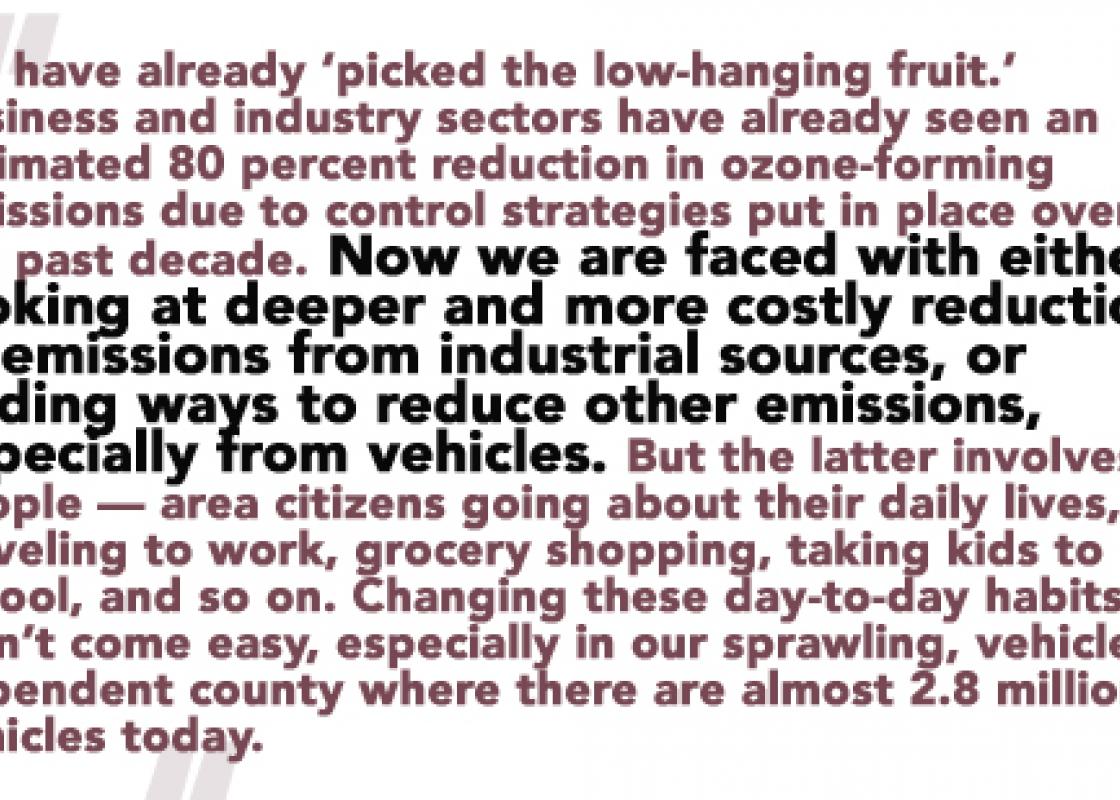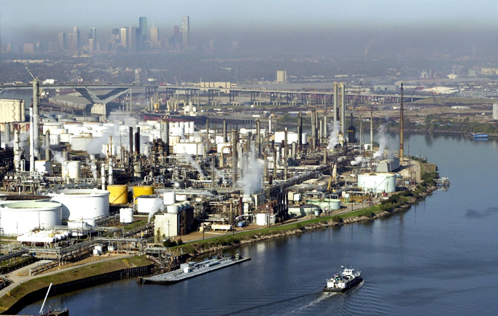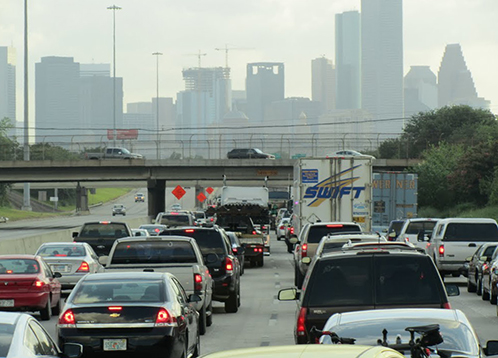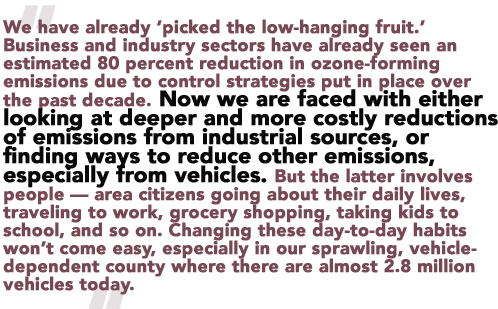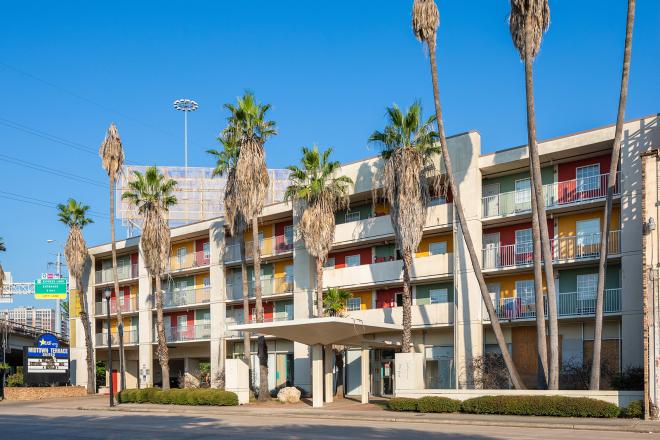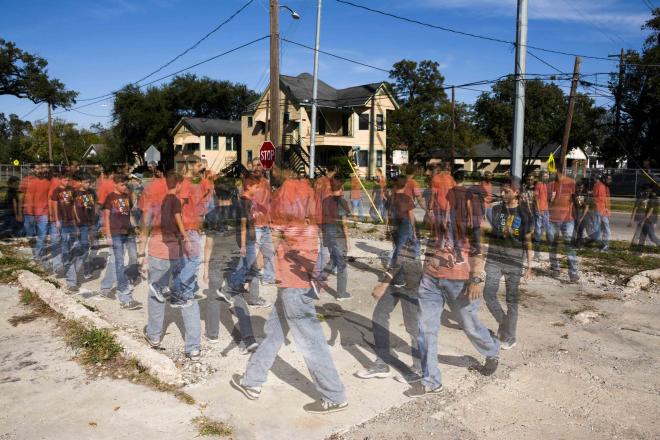The post below is the second in a two-part series on the complexities of air pollution in Houston. Click here to read Part 1. Each post excerpts “Growing Risks” by Larry Soward, a former Commissioner at the Texas Commission on Environmental Quality. The full article is available in the print issue of Cite 93.
THE COSTS
So, given all this growth and economic development that is happening or about to happen in the Houston region, what are the costs in terms of risks to our environment, our health, and our quality of life? The most significant costs stemming from all this growth are the impacts on public health. Out of a total population of almost 4.2 million in Harris County, over 93,000 suffer from pediatric asthma; almost 223,000 suffer from adult asthma; 156,000 live with COPD; almost 1 million have cardiovascular disease; 300,000 have diabetes. At particular risk are the almost 1.2 million residents who are children under age 18; more than 350,000 individuals who are 65 and over; and the more than 800,000 people who live in poverty. Most of the expected major industrial growth will be in communities along the Ship Channel which are already inundated with petrochemical plants and refineries and overburdened with pollution and health risks. Already experiencing higher levels of air pollution, increased incidents of cardiac and respiratory illnesses and increased risks of air toxics-related illnesses, these communities will very likely have their health problems made even worse.
Houston Ship Channel. Photo: Wikimedia Commons.
Exposure to elevated levels of ozone and fine particles in the air can cause or aggravate various respiratory symptoms, including decreased lung capacity, asthma, inflammation of lung tis- sue, and chronic bronchitis. Regular or prolonged exposure can also impair the body’s immune system defenses, making people more susceptible to infections and diseases. Increased air pollution levels have been linked to increased cardiac and respiratory-related emergency room visits, hospital admissions, work and school absences, and even higher death rates. A recently released study by Rice University researchers, published in the American Heart Association's journal Circulation in February 2013, found a direct link between out-of-hospital cardiac arrests and levels of air pollution and ozone. Based on data collected from Houston’s network of air-quality monitors and the more than 11,000 out-of-hospital cardiac arrests logged by Houston Emergency Medical Services between 2004 and 2011, the Rice researchers found that a daily average increase in particulate matter of 6 micrograms per day over two days raised the risk of cardiac arrest by 4.6 percent, and each increase of 20 parts per billion in the ozone level over one to three hours also increased the risk of cardiac arrest up to a peak of 4.4 percent. The study found that 55 percent of these heart attacks occurred during the summer months; that patients died in more than 90 percent of the cases; and that risks were higher for men, African-Americans, and people over age 65. An American Lung Association study also found that children who play active team sports in areas with high levels of ozone are more likely to develop asthma.
Studies conducted at the University of Texas Medical Branch in Galveston found that healthy adults experienced increased airway obstruction as ozone levels increased throughout the day, even when those levels remained far below national standards. Exposure to air toxins in high concentrations can precipitate nausea, headaches, confusion, seizures, severe difficulty in breathing, and sometimes death. Other severe health effects that can result include cancer and various immunological, hormonal, neurological, reproductive, developmental, and respiratory effects, depending on the specific air toxin, its concentration, and exposure time. Many air toxins are neurotoxins and can cause genetic damage.
From a regulatory standpoint, the Houston area has consistently failed to meet national air quality standards for ozone. We have failed to meet the 30-year-old one-hour ozone standard of 125 parts per billion (ppb) and the 1997 eight-hour standard of 85 ppb. The Houston area is now classified as “marginal” in nonattainment for the new 2008 ozone standard of 75 ppb. Our ozone levels currently rank seventh-highest on the list of major cities, and the American Lung Association recently gave Houston a failing grade for ozone pollution, ranking it eighth-worst among all cities. The number of “ozone alert” days yearly continues to be high: 47 in 2011 and 35 in 2012. Yet we are currently relying on control strategies put in place to meet the old ozone standard in order to attain the new standard or create some margin of safety. These facts become even more significant given that the federal Clean Air Act requires that the 2008 ozone standard be reviewed again this year, and it could be lowered even more.
Furthermore, the Houston area hovers perilously close to nonattainment of the new annual standard for fine particulate matter. As with ozone, the American Lung Association has given Houston an F for particulate matter pollution, ranking it 23rd worst in year-round particle pollution. While many predict Harris County can meet the new standard by 2020 without undertaking any further actions to reduce emissions beyond the controls currently required or planned, all the expected population and economic growth in the region, coupled with our already significant air pollution problems, present significant challenges to achieving and maintaining the new standard.
Toxic air pollutants, such as benzene, styrene, 1,3-butadiene, and others, are also significant in certain areas in and around Houston, such as the highly industrialized East Side along the Ship Channel. While we have made progress in reducing these toxic air pollutants, existing or new sources remain of significant concern and we must continue to focus on necessary strategies to address them.
Finally, Texas ranks first in the nation and eighth in the world in greenhouse gas emissions. The Gulf Coast area is the epicenter of these emissions, with Harris County leading all counties in the nation in CO2 emissions.
Undoubtedly, all the expected population and economic growth in the region is coming at a time when improving our air quality is already the largest environmental and health challenge we face in the Houston area. Again, all the planned major expansion projects along the Ship Channel and among the refining and petrochemical facilities in the region will only make our current air pollution problems worse. Equally significant is the fact that the almost 2.8 million vehicles in Harris County today are predicted to double by 2040. According to Houston-Galveston Area Council regional transportation studies, by 2040 nearly all of the region’s major roadways will have more demand than what they are designed for, and most of the future population growth will occur in new and emerging areas of the region that are not currently served by public transit or have no current plans for future transit services. Since vehicles currently account for over 70 percent of ozone-forming nitrogen oxide, more vehicles simply mean more air pollution.
THE SOLUTIONS
So, what can we do to meet the enormous challenges associated with cleaning up our air at a time of mushrooming population and economic growth? We certainly can’t relax our focus or our efforts, saying like Scarlett O’Hara, “Tomorrow is another day.” While we have made significant, positive progress towards cleaning up our air, we still have a long way to go.
Furthermore, simply meeting minimal air quality standards likely will not achieve our goals. We have no room for complacency, no room for the status quo. We will have to push harder and stretch further than we ever have to make a significant difference. Changing our driving behavior to reduce air pollution and ensure a cleaner, healthier environment now and in the future will require new thinking and open minds in order to develop new and creative strategies. For example, we should encourage strategies like increased mass transit ridership, telecommuting to allow employees to work from home instead of driving into work, or creating more flexible four-day work weeks to eliminate one day’s commute. We must also continue the development of cleaner-burning, less-polluting fuels, and should expand upon strategies such as idling reduction.
Houston is an excellent example to dispel the inevitable “doom’s day” claims that enhanced environmental protection will surely stall an economic engine and cause our economy to suffer. We have experienced tremendous economic growth and prosperity in recent years and are enjoying one of the strongest and most extensive economic development eras in history. All this has occurred while making significant efforts in every sector to deal with the major and far-reaching environmental issues and challenges of improving our environment. We have shown we can continue to improve our environment, our health, and our quality of life while ensuring a sound and growing economy. We must continue that sound approach.
More >>>
Read Part 1 of this essay; read all Cite 93 content.


